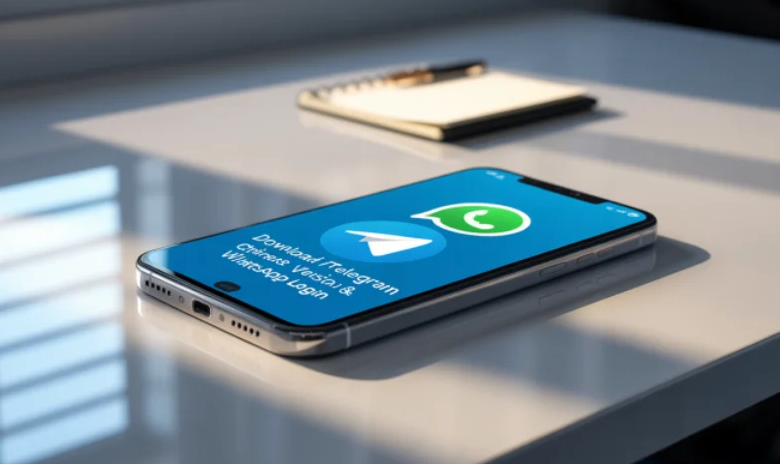Differences Between WhatsApp Web Version Login and Telegram Chinese Desktop Mode

Introduction
In the modern era of digital communication, desktop applications for popular messaging platforms have become indispensable tools for productivity and seamless connectivity. Two of the most prominent players in this field are WhatsApp and Telegram. While both offer robust desktop experiences, their approaches, particularly regarding the login process for WhatsApp Web and the overall functionality of Telegram’s desktop client, often referred to in the context of its Chinese desktop mode, differ significantly. Understanding these differences is crucial for users who rely on desktop messaging for both personal and professional use. This article delves into the core distinctions between the WhatsApp Web Version Login and the Telegram Chinese desktop application, highlighting their unique architectures, security models, and feature sets.
Architectural Foundation: Tied to Mobile vs. Independent Client
The most fundamental difference lies in the core architecture of their desktop offerings. The WhatsApp Web Version Login process is fundamentally an extension of your mobile phone. It operates on a mirroring principle. To initiate the WhatsApp Web Version Login, you must open the web application in a browser or launch the dedicated desktop app, and then scan a QR code using the WhatsApp application on your smartphone. This action does not log you into a separate account; instead, it establishes a secure connection that mirrors your phone’s WhatsApp session onto the larger screen. Your phone remains the primary device, acting as the server that relays all messages. If your phone loses internet connectivity or battery power, the Whatsapp网页版登入 session becomes inactive, severing your connection to the desktop interface.
In stark contrast, the Telegram Chinese desktop application, like all Telegram desktop clients, is a fully independent program. It does not merely mirror your phone. You can log in using your phone number and a one-time code sent via SMS or delivered through your already active Telegram app. Once logged in, the desktop client operates autonomously. Your chats, groups, and channels are synchronized across all devices, but the desktop app can function perfectly even if your smartphone is turned off or disconnected. This standalone architecture is a cornerstone of the Telegram Chinese desktop experience, offering a level of independence and reliability that the tethered model of WhatsApp Web cannot match.
The Login and Authentication Experience
The login experience directly reflects this architectural divide. The WhatsApp Web Version Login is universally consistent: scan the QR code. This method is simple and leverages your phone’s existing authentication, avoiding the need to remember a separate password. However, it is also its biggest limitation. You cannot access your WhatsApp account on a desktop without having your physical, powered-on smartphone with you and connected to the internet. This can be a significant hurdle if your phone is lost, damaged, or simply out of battery.
The Telegram中文 desktop mode, adhering to Telegram’s global standard, offers a more versatile login procedure. While it supports QR code scanning for convenience, its primary method involves SMS verification. This means you can log into a new desktop instance from anywhere, as long as you can receive an SMS on your registered number or approve the login from another active Telegram session. This flexibility is a major advantage for users who frequently switch between devices or need to regain access when their primary phone is unavailable. The Telegram Chinese desktop application empowers the user with multiple pathways to access their account.
Security and Privacy Considerations
Both platforms employ end-to-end encryption, but their scope differs, impacting the desktop experience. WhatsApp’s end-to-end encryption is a default feature for all personal chats and calls, and this protection extends to the WhatsApp Web Version Login. Because the desktop client is a direct mirror of the phone, the encryption keys remain on your mobile device, maintaining a high security standard. However, the constant dependency on the phone is a single point of failure from an accessibility standpoint.
The Telegram Chinese desktop application exists within Telegram’s unique security framework. While personal “Secret Chats” are end-to-end encrypted and are exclusively available on mobile devices, all regular cloud chats are encrypted client-to-server/server-to-client. This cloud-based architecture is what enables seamless multi-device support, including the robust Telegram Chinese desktop mode. Users can have multiple active desktop and mobile sessions simultaneously, all synchronized. For the vast majority of users, this offers a practical balance of security and convenience, though those requiring end-to-end encryption for all communications must use the Secret Chat feature, which is mobile-only.
See also: Software Technology and the Rise of Online Gambling
Feature Set and User Interface
The feature parity between mobile and desktop is another area of significant divergence. The WhatsApp Web Version Login grants access to a interface that is largely identical to the mobile app’s core functions: sending messages, images, videos, and documents, and participating in voice and video calls. However, it often lags in introducing new features; updates typically debut on mobile first.
The Telegram Chinese desktop application is renowned for its feature-rich environment that often matches or even exceeds the mobile experience. It supports advanced functionalities like multiple account logins, extensive customization options, powerful message scheduling, and the ability to handle very large files and downloads seamlessly. The interface of the Telegram Chinese desktop client is designed for power users, with a focus on keyboard shortcuts and a layout optimized for a mouse and keyboard workflow, making it highly efficient for heavy messaging and channel management.
Conclusion
The choice between using the WhatsApp Web Version Login and the Telegram Chinese desktop mode ultimately depends on a user’s priorities. The WhatsApp Web Version Login offers a simple, secure, and straightforward way to access your messages on a larger screen, but it does so at the cost of absolute dependency on your smartphone. It is an extension, not a standalone solution. Conversely, the Telegram Chinese desktop application is a testament to Telegram’s philosophy of independence and power. It functions as a fully-fledged, independent client with a flexible login process, robust multi-device support, and a rich feature set tailored for productivity. For users seeking a desktop messaging experience that is autonomous, versatile, and packed with features, the Telegram Chinese desktop mode presents a compelling and superior alternative to the tethered nature of the WhatsApp Web Version Login.



